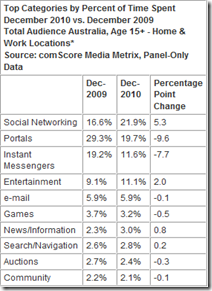 Social networking category leader Facebook continued its momentum as it amassed millions of new users and people spent more and more of their time on the site, according to a new white paper from comScore. “The 2010 US Digital Year in Review” indicates that Facebook accounted for 10% of US page views in 2010, while three out of every 10 US internet sessions included a visit to the site.
Social networking category leader Facebook continued its momentum as it amassed millions of new users and people spent more and more of their time on the site, according to a new white paper from comScore. “The 2010 US Digital Year in Review” indicates that Facebook accounted for 10% of US page views in 2010, while three out of every 10 US internet sessions included a visit to the site.
MySpace Weakens Hold on Second Place
Although MySpace currently maintains its hold on the number two ranking in the social networking category with 50 million visitors in December 2010, its audience declined 27% and total time spent on the site declined 50%.
Business-oriented social networking site LinkedIn emerged as the third-largest site in the category with 26.6 million visitors in December 2010 Meanwhile, number four Twitter climbed to 18% to 23.6 million visitors in December 2010 (not counting third-party app or mobile usage).
In addition, a couple of surprise sites emerged as players in the social networking space this year, as Tumblr.com surged 168% to 6.7 million monthly visitors, while Formspring.me rose in popularity among younger social networkers and grew more than 1,000% year-over-year.
Facebook Gains Across Dimensions
 In addition to its snowballing user base, Facebook grew significantly across nearly every performance metric in 2010. Facebook’s US audience grew to 153.9 million in December 2010, an increase of 38%, as it became the fourth-most visited web property, reaching nearly three out of every four US web users each month. Engagement metrics fared even better, with Facebook’s total time spent surging 79% year-over-year to 49.4 billion minutes and total page views growing 71% to 76.8 billion.
In addition to its snowballing user base, Facebook grew significantly across nearly every performance metric in 2010. Facebook’s US audience grew to 153.9 million in December 2010, an increase of 38%, as it became the fourth-most visited web property, reaching nearly three out of every four US web users each month. Engagement metrics fared even better, with Facebook’s total time spent surging 79% year-over-year to 49.4 billion minutes and total page views growing 71% to 76.8 billion.
comScore analysis indicates Facebook’s overall growth in 2010 can be attributed to a growing number of people using Facebook, visiting more frequently, and viewing more content on each visit.
Facebook Gains Younger, Older Users
 comScore analysis of the composition of visitors to Facebook and Twitter revealed shifting user demographics during the past year. Facebook saw its 35-54 year old share of visitors decline 9% from 39% to 35.4%, while the younger than 18 segment increased 12% from 9.9% to 11.1%, while users 55 and older about 17% from 11.3% to 13.2%.
comScore analysis of the composition of visitors to Facebook and Twitter revealed shifting user demographics during the past year. Facebook saw its 35-54 year old share of visitors decline 9% from 39% to 35.4%, while the younger than 18 segment increased 12% from 9.9% to 11.1%, while users 55 and older about 17% from 11.3% to 13.2%.
Twitter.com, meanwhile, saw a roughly 24% gain in the share of 18-34 year olds visiting the site, but those younger than 18 declined 46% from 17.5% to 9.5%. comScore analysis suggests this shifting composition may partially reflect a shift among younger Twitter users towards other communication vehicles and third-party Twitter apps.
9 in 10 Web Users Visit SocNet Sites
comScore data indicates nine of 10 US online users visited a social networking site each month in 2010. Social networking sites accounted for 12% of all time spent online in 2010, with the average internet user spending more than 4.5 hours on social networking sites each month.
Globally, social networking accounts for 15.6% of online time among those age 15 and older. Among this same age population, social networking accounts for 14.4% of Americans’ online time.
Women Lead Men in SocNet Use
 One demographic trend that continued in 2010 was women extending their lead on men in the share of their online time spent on social networking sites. Specifically, women spent 16.8% of their online time on social networking sites, up 36.5% from 12.3% of their online time a a year earlier.
One demographic trend that continued in 2010 was women extending their lead on men in the share of their online time spent on social networking sites. Specifically, women spent 16.8% of their online time on social networking sites, up 36.5% from 12.3% of their online time a a year earlier.
By comparison, men spent 12% of their time on social networking sites in December 2010, up 32% from 9.1% a year earlier. So comScore data shows women not only use these sites more than men, but they are also accelerating their usage at a faster rate.
Facebook Only Top 5 Site to Boost Engagement
Facebook is the only one of the top five US internet sites by audience to significantly increase its share of total US internet time between December 2009 and December 2010, according to other comScore analysis. Microsoft remained roughly flat at around 6%, while AOL slightly dropped from a little more than 4% to a little less than 4%.
Meanwhile, Google Sites slightly increased its internet time share to wind up accounting for close to 10%, and Yahoo went from a little more to a little less than the 10% mark.
 One of the easiest ways to stay up to date with the latest on social media, technology and internet marketing, is to get the news delivered straight to your email inbox as it happens.
One of the easiest ways to stay up to date with the latest on social media, technology and internet marketing, is to get the news delivered straight to your email inbox as it happens.































